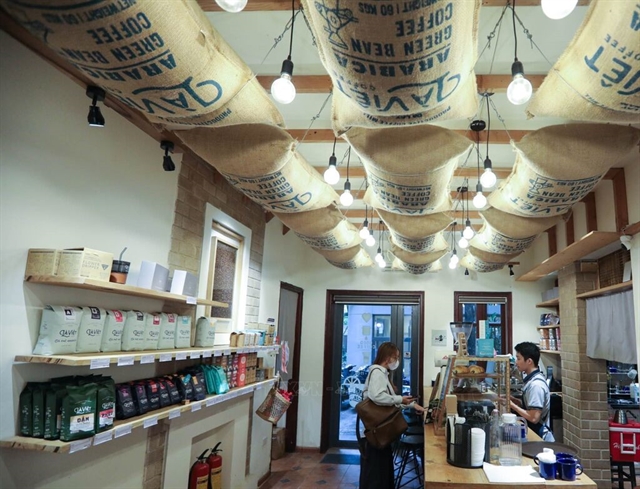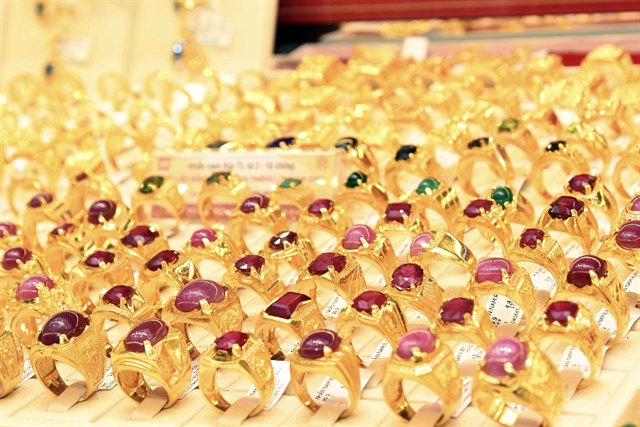 Business Beat
Business Beat

Compiled by Thiên Lý
Hào Sỹ Phường is one of HCM City’s odest alleys. It houses 100-year-old apartment buildings in popular Chinese colours in HCM City’s District 5.
According to https://vinlove.net, Hào Sỹ Phường is the first suggestion made to those looking for an old apartment building to take pictures of an extremely beautiful living place.
Like many other Saigon alleyways, time seems to stand still in Hào Sỹ Phường. The old apartment buildings there stand proudly, tin roofs in the Sài Gòn heat and signs of change hard to find. Cut off from the hustle and bustle outside, it offers a calm and peaceful sight.
The web says Hào Sỹ Phường's are among the top old apartment buildings in HCM City which are sure to provide a strange background to your photos.
Nguyễn Huệ apartment building is also listed by vinlove.net as one of the top destinations for those who want to discover pretty features of erstwhileSài Gòn.
Nguyễn Huệ is one of the busiest streets in HCM City, and Nguyễn Huệ apartment building is located right at the best location.
Since Nguyễn Huệ Street was renovated, with its median strip turned into a pedestrian plaza, this 60-year-old building has become wellknown thanks to its dozens of shops and cafes decorated in unique and classic colours.
It is the perfect stop if someone wants to spend a day treating themselves to the best coffee, snacks, books, and a pedicure.
Phạm Thúy Loan, architect and deputy director of the National Institute of Architecture, says of Tăng Bạt Hổ apartment building in Hà Nội’s Hoàn Kiếm District,“For Hanoians of the 6X, 7X, 8X generations like us, the old apartment building brings back a childhood full of vivid memories.”
It was where she was born and grew up with together many other children.
She told Hanoitimes.vn that it is a memory of happiness and warmth in this apartment block.
“There were typical yellow doorways and the stairs glittering with lights from slots in the concrete walls, the voice of residents there summoning street food vendors, and the buzz of old people and kids in the yard.
“All these are beloved spaces for those who grew up in the old apartment buildings.”
Old apartment buildings are architectural landmarks in cities, telling people their historical stories, and thus they have become part of a “common memory”.
Architects warn memories of cities will also be wiped out if these are replaced.
Old apartment buildings in major cities like Hà Nội and HCM City have great spiritual, cultural and commercial significance, including for tourism.
But with time many have deteriorated, requiring proper treatment.
Poor conditions
Most old residential buildings are no longer fit for living and are in very poor condition. Many even pose a threat of collapse, endangering occupants, which has caused city governments to consider quick remedial action.
According to the Hà Nội Department of Construction, there are some 1,579 old apartment buildings in the city, most of them built between the 1960s and 1992 though some were built before 1954.
They are mainly in inner districts like Ba Đình, Hoàn Kiếm, Đống Đa, and Hai Bà Trưng.
Of the buildings, 1,273 are in 76 apartment complexes.
More than 400 buildings show signs of posing a risk.
Of them,148 are classified as B-grade, meaning usable but with some parts degraded; 145 are graded C, which means some parts are in dangerous condition and require reinforcement; and eight are graded D, which means they face a threat of collapse and need instant renovation and evacuation of occupants.
HCM City has 474 dilapidated apartment buildings built before 1975, of which D grade accounts for 15, C for 115 apartments and B for 332. The remaining 12 have already been knocked down or have had their occupants relocated.
According to a recent report by the Hà Nội construction department, some 25 per cent of old apartment buildings are “very dangerous” and could collapse at any time, putting the lives of their occupants at risk.
HCM City has a similar rate.
The question is how to fix the decrepit apartment buildings so that they both provide accommodation and are safe for people, since a majority of big cities like Hà Nội and HCM City face a serious shortage of housing, while still safeguarding their cultural aspects.
Analysts said there are two options for old buildings: one is demolition and reconstruction and the other is restoration and renovation.
The first is easier to do, and also offers greater commercial value to the Government and investors.
But this could result in breaking social cohesion.
The other option is to renovate old buildings in a way that not only preserves their architectural and cultural aspects but also ensures good living conditions for occupants.
Analysts said it would also help improve cities’ looks and boost economic development in these areas.
It means renovating old buildings to improve their interior and exterior aspects to meet the needs of modern life without harming their cultural and social aspects.
This is a popular option among occupants of old apartments but an expensive one.
Authorities in places like Hà Nội and HCM City say they have for years sought to renovate or rebuild old apartment buildings but have met many obstacles.
In the last 20 years Hà Nội has renovated only 19 old apartment buildings and work is going on at 14 others.
HCM City has in the last five years demolished only four D-grade buildings and relocated the occupants of six others which were in dangerous condition. But there are no plans yet to rebuild or renovate the latter.
Only two old apartment buildings were rebuilt.
Reasons for delay
Trần Ngọc Hùng, chairman of the Việt Nam Construction Association, said the national programme to renovate or reconstruct old apartment buildings was launched over a decade ago to improve people’s lives and cities’ appearance, but has proceeded very slowly.
He said hurdles are caused by the illogical mechanisms and policies related to planning, compensation, selection of developers, resettlement, and returns for developers and residents.
Some other regulations remain on paper and have yet to be implemented, he said.
Under Government Decree No 61/1994, housing developers are allowed to demolish degraded buildings with the consent of apartment owners.
After an agreement is reached with all occupants, developers submit construction plans to related authorities for approval.
Decree No 101/2015/ND-CP gives owners of dangerous and severely degraded apartment buildings three and 12 months respectively to choose developers to demolish and rebuild them and decide compensation amounts.
If they fail to do so, the Government will take over responsibility for selection of developers and demolition.
The reality has been that it is almost impossible for all apartment owners to come on board since computing compensation is a complex affair and many are unhappy with the valuation and refuse to move out.
Developers are not keen on renovation projects either because of irrational regulations and restrictions on buildings in inner districts.
For instance, Decree No 101 requires the height of the new building and number of apartments to be exactly the same as in the demolished one.
But for developers, building four or five floors like in the old buildings makes little financial sense and would prefer to build 15 floors or more.
Wayout
In July this year the Government issued a new decree on renovation and reconstruction of apartment buildings, including a legal framework for compensation and resettlement of occupants.
Decree No 69/2021/ND-CP, which took effect from September 1, 2021, has new mechanisms and regulations that address most of the problems, and could help attract developers.
Analysts expect it to be a major step towards the renovation and reconstruction of old apartment buildings in cities since it clearly defines what types of old buildings need renovation or reconstruction and spells out compensation and resettlement provisions. "Wait for change”. — VNS




